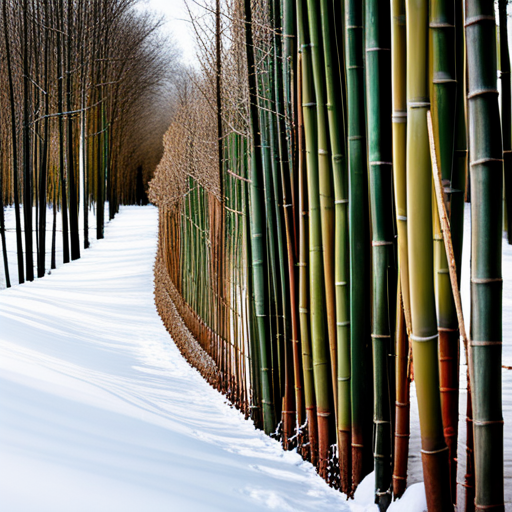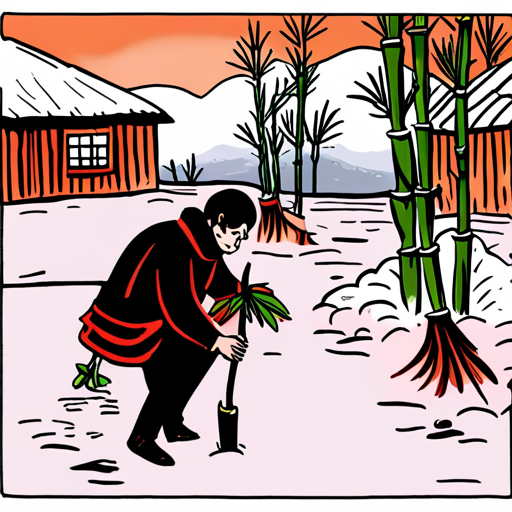Bamboo, a versatile and fast-growing plant, is often associated with warm, tropical climates. However, with the right knowledge and techniques, it is possible to successfully grow bamboo in cold climates as well. This article aims to provide tips and techniques for growing bamboo in such challenging environments.
The first step in cultivating bamboo in cold regions is to select cold-hardy species. This can be determined by referring to the USDA Plant Hardiness Zone Map and purchasing plants from local nurseries or growers in similar climates. Proper planting and location are also crucial. It is important to choose a spot that meets the specific growth requirements of bamboo, ensuring adequate sunlight, soil conditions, and drainage.
Winter protection measures are essential to safeguard bamboo from harsh weather conditions. Generous mulching around the plantings helps prevent the root zone from freezing. Additionally, laying down culms or planting near a barrier can protect the bamboo from strong winds. For extremely cold areas, growing bamboo in containers allows for easy indoor movement during freezing temperatures.
It is important to note that bamboo shedding leaves in winter is a natural phenomenon, and the plants will regrow in the spring. By following these tips and techniques, bamboo can thrive and bring beauty to even the coldest climates.
Contents
- 1 Our Highlighted Points
- 2 Choosing Cold-Hardy Species
- 3 Proper Planting and Location
- 4 Winter Protection Measures
- 5 Frequently Asked Questions
- 5.1 How often should bamboo be watered during the winter months?
- 5.2 Can bamboo survive in areas with heavy snowfall?
- 5.3 Are there any specific soil requirements for growing bamboo in cold climates?
- 5.4 How long does it take for bamboo to regrow its leaves in the spring?
- 5.5 Are there any pests or diseases that commonly affect bamboo in cold climates?
Our Highlighted Points
- Select cold-hardy bamboo species based on USDA Plant Hardiness Zone Map.
- Ensure adequate sunlight, soil conditions, and drainage for bamboo.
- Implement winter protection measures to safeguard bamboo.
– Container gardening provides extra layer of protection against the cold.
Choosing Cold-Hardy Species

Choosing cold-hardy bamboo species is crucial when growing bamboo in cold climates. It ensures that the plants can withstand the harsh winter conditions and continue to thrive. There are several benefits of growing bamboo in cold climates. It can add a unique and exotic touch to the garden while providing privacy and shade. However, there are common challenges in growing cold-hardy bamboo species. These include the risk of plant damage from freezing temperatures and snow accumulation. To overcome these challenges, it is important to select bamboo species that are specifically adapted to cold climates. By choosing cold-hardy varieties, gardeners can enjoy the beauty and benefits of bamboo while ensuring the survival and growth of the plants in challenging winter conditions.
Proper Planting and Location

When selecting a suitable location for planting bamboo in cold climates, it is important to consider the specific growth requirements of the species and ensure that the chosen spot meets these criteria.
Bamboo plants thrive in well-drained soil with a pH level between 6.0 and 6.5. They require full sun or partial shade for optimal growth.
Additionally, it is crucial to protect bamboo from strong winds by either laying down culms or planting it near a barrier.
Another consideration is growing bamboo in containers, which provides the benefit of easy indoor movement during freezing temperatures. Container gardening allows for proper bamboo maintenance and ensures that the plants are protected from the harsh winter elements.
By carefully selecting the right location and implementing proper maintenance techniques, bamboo can successfully grow in cold climates.
Winter Protection Measures

To protect bamboo plants in cold climates, it is important to implement measures such as shielding them from strong winds, mulching generously around the plantings to prevent the root zone from freezing, and considering container gardening for easy indoor movement during freezing temperatures.
When it comes to protecting bamboo from frost, snow, and ice during winter, it is crucial to take the following steps:
- Shielding from strong winds: Laying down culms or planting bamboo near a barrier can help protect it from the damaging effects of strong winds.
- Mulching for winter protection: Applying a thick layer of mulch around bamboo plantings helps insulate the root zone and prevent it from freezing.
- Container gardening: Growing bamboo in containers allows for easy indoor movement during freezing temperatures, providing an extra layer of protection against the cold.
By implementing these winter protection measures, bamboo plants can thrive even in cold climates.
You may also like to read about growing bamboo in the desert and related essential care tips.
Frequently Asked Questions
How often should bamboo be watered during the winter months?
Bamboo water requirements during winter depend on factors such as temperature, precipitation, and soil conditions. It is important to monitor soil moisture and only water when necessary to prevent overwatering, as excessive moisture can lead to root rot and other issues.
Can bamboo survive in areas with heavy snowfall?
Winter protection is crucial for bamboo in areas with heavy snowfall. Choose cold hardy bamboo varieties, protect plants from snow accumulation by shaking off snow or using supportive structures, and provide additional insulation with mulch or burlap wraps.
Are there any specific soil requirements for growing bamboo in cold climates?
Soil composition and optimal pH levels are important factors for growing bamboo in cold climates. Bamboo prefers well-drained soil with a pH range of 6 to 6.5. It requires a fertile soil with adequate organic matter to thrive in cold regions.
How long does it take for bamboo to regrow its leaves in the spring?
The speed at which bamboo regrows its leaves in the spring, known as the spring growth rate or bamboo leaf regeneration speed, varies depending on the species and environmental conditions.
Are there any pests or diseases that commonly affect bamboo in cold climates?
Pest management and disease prevention are crucial for maintaining healthy bamboo in cold climates. Common pests include aphids, mites, and beetles, while diseases like fungal infections can also occur. Regular monitoring, proper sanitation, and targeted treatments are essential for controlling these issues.

